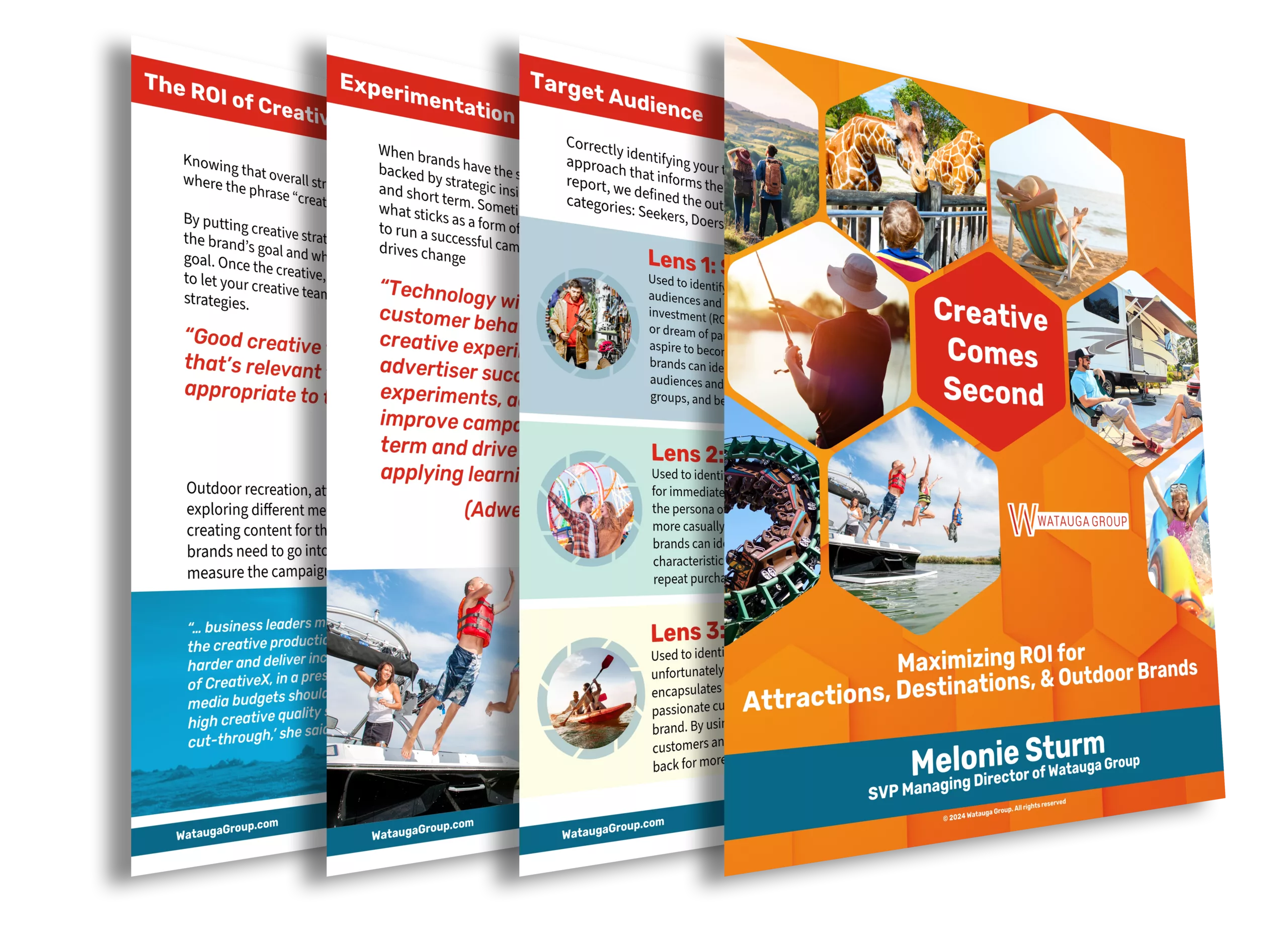In the realm of advertising, particularly for outdoor brands, destinations and attractions the mantra “creative comes second” is a phrase that Watauga Group uses with our clients to strategically guide and direct the timing and development of creative materials and campaign advertising. This strategic formula begins with first building an overall marketing or advertising strategy – including the paid media strategy – and only then diving into the creative development process. By prioritizing a comprehensive strategy, brands can maximize their marketing ROI, enhance brand awareness, and boost sales or visitation. Let’s look into why this approach is crucial and how it can transform marketing campaigns.
The “Creative Comes Second” Formula
When we say, “creative comes second,” we mean that the creative development process surrounding an advertising campaign should follow a specific, end-to-end formulaic strategy. This approach involves first developing the campaign’s overall strategic plan based on the client’s unique business and marketing goals, followed by a tightly integrated advertising media and creative strategy, and then executing the advertising creative based on these two primary strategic directives. Without a comprehensive campaign strategy that considers both the campaign’s business objectives as well as the target audiences’ unique media habits and preferences, creative efforts can be misdirected, leading to a lot of wasted time and resources.
For example, an outdoor brand targeting adventure enthusiasts might discover through consumer or customer research that their target audience prefers visually rich short-form video content best presented on platforms like Instagram and YouTube. Using an overall strategy based on these and other insights, the creative team can then focus on developing visually engaging product or brand video content tailored for these specific media platforms, ensuring it resonates with the audience, inspires high customer engagement, and meets the campaign’s business goals. Without having followed a strategic formula to guide such insights, brands run the risk of pursuing and developing advertising creative that does not resonate with their target audience(s) and falling short of delivering their campaign and business objectives.
Diversifying Creative Across Channels
For outdoor brands and travel destinations, a common pitfall in advertising campaign development is using the same creative content across different paid media types. Each media type has its unique characteristics and user engagement patterns, needing a tailored approach. A website banner ad, for instance, should not be directly repurposed for an Interstate billboard. The way consumers interact with a banner ad on their laptop or smartphone is vastly different from how they perceive an interstate billboard while driving past it at potentially high speed. Understanding these differences and how audiences engage and then applying this expertise are why using the Creative Comes Second approach is vital for marketing success.
Consider a travel destination promoting an ecotourism trail. For social media platforms like Instagram, a short, engaging video highlighting the trail’s scenic beauty and key features can be a scroll-stopper, inspiring consumers scrolling through their feeds to pause and engage with the content. In contrast, a mobile banner viewed on a smartphone could be delivered through a geo-targeted radius of a trailhead map pin and delivered based on a user’s mobile device location. This ad could be more informative and directional in nature, showing an opportunity for a visitor to have a new experience while they are in-destination. Developing advertising creative that aligns with the correct stage of a consumer’s journey is another way the formulaic approach of Creative Comes Second can be applied to a brand’s marketing efforts.
A more nuanced example involves a Facebook newsfeed ad designed to build awareness for an outdoor brand versus a banner ad on a blog aimed at enthusiasts of a specific outdoor activity. The former might focus on broad, more general visually appealing brand content to grab attention, while the latter could provide detailed product information and a direct call to action, reflecting the audience’s specific outdoor recreation activities and experience, with the goal of a sales conversion. If the advertising creative on the outdoor blog is not contextually relevant, it will be easily ignored by potential new or even existing customers, therefore wasting valuable marketing dollars.
Research supports this tailored approach: “Companies that consistently produce creative in line with platform best practices typically see a 17% lift in brand recognition, a 30% lift in sales, and a 10% increase in impressions per dollar” (Campaign US Media Post). https://www.campaignlive.com/article/marketers-spent-nearly-1-billion-subpar-ads-2022/1818811
These statistics underscore the importance of customizing creative content to fit the platform’s unique requirements and audience engagement styles.
Measurement and KPIs
Aligning creative development strategies with an advertiser’s business objectives and the most suitable paid media placement to reach those goals ensures that the resulting marketing content is not only compelling but also effective. Once the strategy is set, the creative team can then focus on executing creative advertising elements that tell a clear, relevant story and support the campaign’s goals and objectives.
As Dan Hou, Director of Creative Studios at Amazon Ads, aptly puts it, “Good creative tells a clear, compelling story that’s relevant to your audience and appropriate to the channel” (Adweek). For outdoor brands, destinations, attractions this means creating content that speaks directly to their audience’s interests and behaviors.
In 2024, with advertising budgets often being tight, having a strategic plan before entering the creative development process is more critical than ever. This involves setting clear Key Performance Indicators (KPIs) to measure the campaign’s success based on the strategy. These performance measurements should also be aligned to campaign goals and where on the consumer journey they are being delivered. Understanding that brand awareness advertising running on streaming TV will have a KPI of audience delivery (reach), and be optimized to reach the most consumers within a defined target audience. Much further into the consumer journey is an opportunity for a paid social ad to deliver a product offer on Instagram and be measured by and optimized to sales conversions. These two paid media placements require different creative advertising assets and will be measured differently but are both laddering up to the same campaign goal of increased sales.
Putting a Creative Comes Second formula into advertising campaign development is a strategic move that pays dividends. By prioritizing a comprehensive strategy, brands can ensure that their marketing efforts are targeted, relevant, and effective. This formulaic approach not only enhances brand awareness and sales but also maximizes the return on advertising spend. For outdoor brands, destinations, and attractions looking to make a significant impact, this strategy is not just beneficial—it’s essential.
If you would like to know more about the Creative Comes Second formula for success, the full report is available to download free here. https://wataugagroup.com/creative-comes-second-report/






